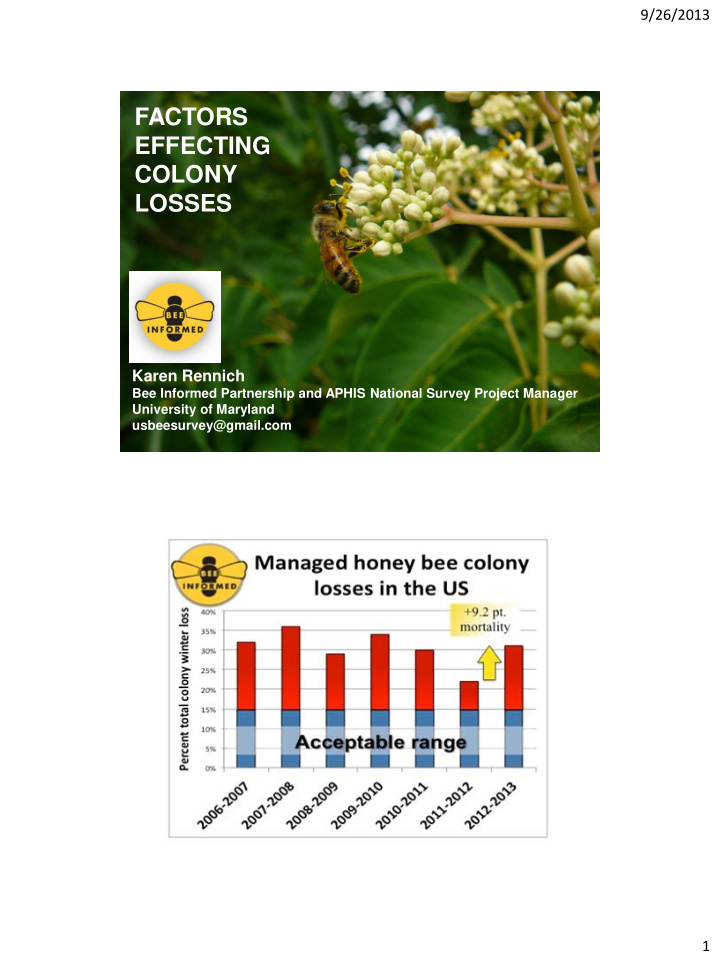



9/26/2013 FACTORS EFFECTING COLONY LOSSES Karen Rennich Bee Informed Partnership and APHIS National Survey Project Manager University of Maryland usbeesurvey@gmail.com 1
9/26/2013 Bees are in Trouble 60% Why we do what we do 31% “America has around 2,000,000 beehives: maybe more; maybe less. There are 1500 commercial and serious part- time beekeeper families and their employees who are the Gatekeepers of our food supply. Is anybody listening ?” - John Miller In an interview about BIP Also the focus of the book “A Beekeepers L ament” 2
9/26/2013 The United Nations Food and Agriculture Organization has noted that 71 of the 100 crops that provide 90% of human food are pollinated by bees*, and the estimated value of those crops is as much as $200 billion annually. *Managed pollinators and wild bees 3
9/26/2013 4
9/26/2013 Migratory/Commercial beekeeping Operation Type: Migratory vs. Stationary 5
9/26/2013 Causes of Losses Varroa mites Pesticides Poor nutrition/loss of forage Varroa Mites 6
9/26/2013 Varroa mite control product used 7
9/26/2013 Pesticides Pesticides – Coumaphos : 44%, used to treat flies and ticks in livestock, effects nervous systems/mildly toxic to bees – Fluvalinate: 48% – Thymol: 20% – 2, 4 Dimethylphenyl Formamide (a metabolite of Amitraz): 29.6% – Chlorpyrifos: 18%, used to treat grubs (lawn care), ticks, fleas, fire ants, lice, toxic to bees and other wildlife. Sprayed on grains, fruits, nuts, vegetables, cotton, lawns and ornamental plants 8
9/26/2013 Pesticide Finds (n=389) CYC, 23 CARB, 6 FUNG, 171 Varroa, 427 HERB, 70 IGR, 15 MITI, 2 NEO, 22 OC, 2 OP, 81 organic, 76 PYR, 84 Pollen “Old world crops” that evolved with honey bees “New world crops” that bees were hired to pollinate…they preferred wildflowers 9
9/26/2013 Pesticide loads in pollen Fungicides • Found on many agricultural crops and thought to be harmless to bees • Fungicides consumed by bees in the pollen they collect were 3X as likely to be infected from a gut parasite called nosema – Nosema can weaken and even kill colonies and it effects the strength of the foragers – thus diminishing honey crops • Most fungicides are not labeled to caution about spraying during flowering or bee’s flight hours 10
9/26/2013 Poor Nutrition 11
9/26/2013 Conservation Reserve Program (CRP) • 33% less than the greatest acreage in 2007 • USDA Farm Service Agency (FSA): between 2011 and 2012, more than 398,000 acres (620 square miles) of grasslands, forests and other lands were plowed, cleared or otherwise converted to cropland • Smallest area since 1988, yes 25 years ago! Bees are Dying What You can Do 12
9/26/2013 Join a beekeeping club and become a beekeeper 13
9/26/2013 Eat local honey Make meadows not lawns 14
9/26/2013 And try to convince your neighbors to do the same Don’t turn your back on this! 15
9/26/2013 We’re all in this together – thank you! 16
Recommend
More recommend